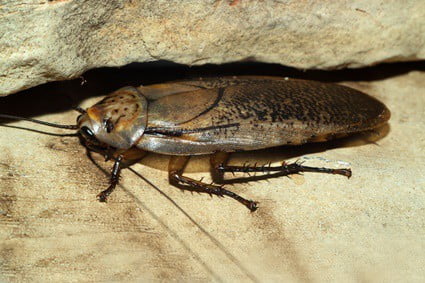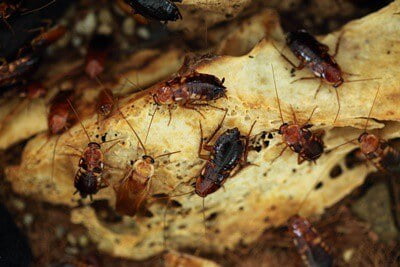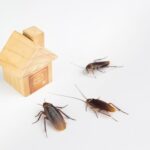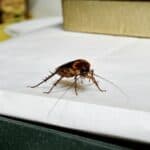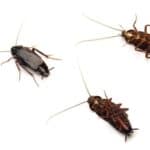Homeowners with cockroach infestations are often confused about where the pests come from, particularly if they’ve sealed all entry points. So, it might not surprise you to know that cockroaches can fit into the smallest spaces due to several essential evolutionary adaptations.
Cockroaches can squeeze through gaps that are half their size and as little as 3mm wide. Newborn nymphs can squeeze through tinier gaps than this, as they’re much smaller than adult roaches. They flatten their flexible exoskeletons and splay their legs out to the side to fit through tiny spaces, making it difficult to keep them out of homes. They’re also fast, reaching speeds of 23 inches per second, even when their bodies are flattened.
Dealing with a cockroach infestation is tricky when you have lots of little entry points in your home. Male cockroaches tend to be slightly smaller and narrower than females, fitting into smaller spaces.
Can Cockroaches Crawl Through Small Spaces?
Cockroaches can crawl through the tiniest gaps due to their impressive flexibility skills. They fit through spaces that are only 3 mm wide – the equivalent of two stacked pennies – and 1/4 of their own standing height.
A study published in the Proceedings of the National Academy of Sciences challenged cockroaches to get through horizontal crevices smaller than a quarter of their standing body height. They found that cockroaches compressed their bodies by 40-60%, traversing small gaps in 300-800 milliseconds.
The reason cockroaches are so hard to catch and kill is because their running velocity, stride length, and stride period only decrease when they’re at the smallest crevice height, as the researchers discovered during the study.
They get into houses and other buildings under doors, through window cracks, and by squeezing themselves through tiny drains and plug holes. Their ability to scuttle so rapidly through small nooks and crannies has allowed them to spread to every corner of the earth, where they protect themselves by running away from predators.
How Do Cockroaches Fit In Small Spaces?
According to Live Science, cockroaches fit through tiny gaps by flattening their exoskeletons, which are fully flexible, to half their size while splaying their legs out to the side. They can also withstand up to 900 times their body weight without injury.
They move through confined spaces at speeds of roughly 23 inches per second, which equates to 20 times their bodies’ length per second. To put this speed into context, this is equivalent to a human measuring 5 feet 8 inches tall moving at more than 75 mph (121 km/h).
That being said, cockroaches move through small spaces slightly slower if there’s friction on the floor or ceiling of the gap. They don’t have friction on their legs, but their bellies and backs slow them down somewhat.
These abilities are so impressive, scientists are developing robots to help first responders find and save rescue disaster victims based on how cockroaches move through the smallest gaps.
Can Cockroaches Get Through Small Holes?
Cockroaches can get through tiny holes if they’re able to flex their exoskeletons and splay their legs. The actual-sized holes cockroaches can get through depends on how big or small they are, but there’s very little that will stop cockroaches from getting to the other side of holes that are bigger than half their size. This is why it’s so difficult to block off entry points into your home.
That being said, cockroaches do have limits on what they can fit through – it all depends on their height and width. Gaps under 3 mm are difficult for adult roaches to crawl into. On the other hand, small nymphs are more likely to fit, so few gaps are safe.
Why Do Cockroaches Like Tight Spaces?
Cockroaches like tight spaces because it protects them from predators. Similarly, nestling into tight spaces makes them feel warm, which is something they need to survive. Tight spaces are more likely to be dark, allowing cockroaches to evade danger and remain hidden from harm. It’s rare to see cockroaches out in the daytime unless the colony’s too large and there’s competition for food and shelter.
Many cockroaches lay their eggs in small, tight spaces, as it keeps them safe and makes them feel secure. They’re drawn to small spots near food and water, enabling them to make frequent scuttle runs. Because other creatures and insects can’t fit in the same spots as they can, they’re relatively safe when they lay low in tight spots.
Another interesting reason why cockroaches like tight spaces is because they’re thigmotropic. This means they’re responsive to touch and enjoy the feeling of solid things against their bodies. The tighter the space, the more comfortable and happier they are.
How Small Can Cockroaches Be?
German cockroaches are the smallest cockroaches, only reaching between 1/2 to 5/8 of an inch in length. Because of their tiny size, they’re the most prevalent cockroach pest in the US, crawling into the tiniest gaps to get inside homes. The smallest German cockroaches can fit into cracks that are as small as a dime.
Brown-banded cockroaches are also tiny, measuring between 1/2 to 5/8 of an inch – the same as German cockroaches. They’re not quite as common, but they’re still an invasive species.
However, nymphs are even smaller, squeezing into even tinier gaps. The most common roach nymphs measure the following:
- American cockroaches: 1/4 of an inch long
- German cockroaches: 1/8 of an inch long
- Brown-banded cockroaches: 1/8 of an inch long
- Oriental cockroaches: 1/4 of an inch long
- Smoky brown cockroaches: 3/8 of an inch long
Nymphs are arguably more of a problem than adult cockroaches because they can squeeze into smaller gaps. It also takes 103 days for them to mature, so they remain small for a significant amount of time.
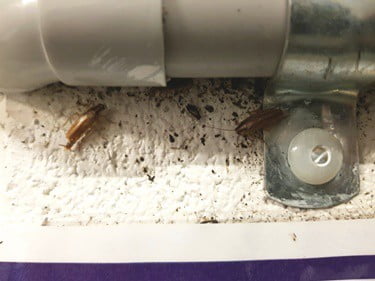
How Small Of a Space Can a Female Cockroach Fit Through?
Female cockroaches can fit into the small gaps, even if they’re pregnant. That’s because they carry their offspring in an egg sac called an ootheca, which protects the young. Cockroaches either deposit the sacs somewhere safe, or they carry them on their abdomens, where they protrude from the back of their bodies like a pill-shaped mass instead of bulging out of their bodies.
Many female cockroaches, especially German roaches, are slightly larger than males, so they can’t fit into the same gaps as the males.
How Small Of a Space Can a Male Cockroach Fit Through?
As mentioned, male cockroaches tend to be slightly more slender than females. As a result, they can fit into the most extreme spaces, including those that are only 3 mm wide or a quarter of their body size.
It’s safe to assume that few small gaps are off-limits for cockroaches. Unless you seal all entry points as tightly as you can, there’s a big risk that they can enter into your home, regardless of how well you think you’ve sealed them.
